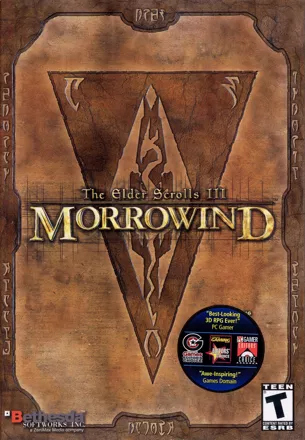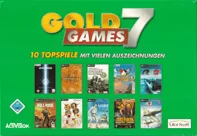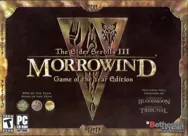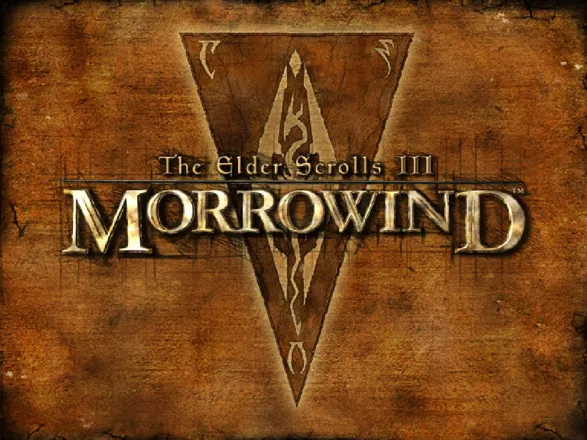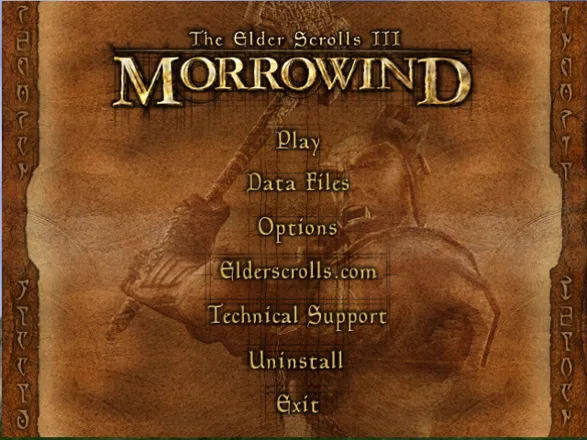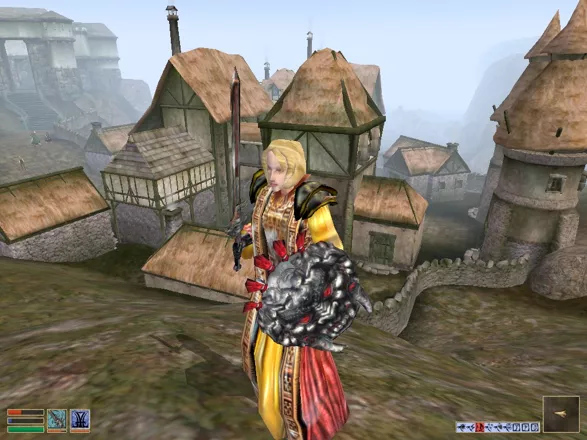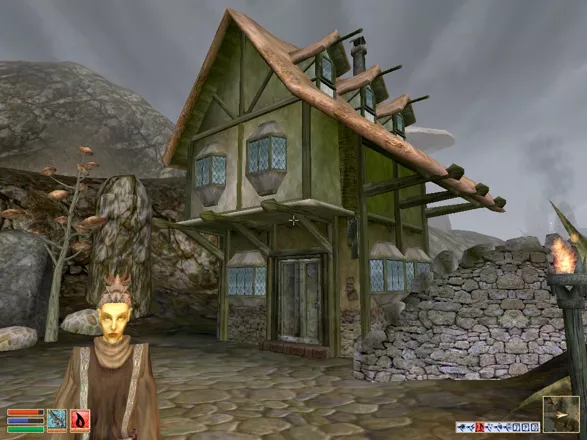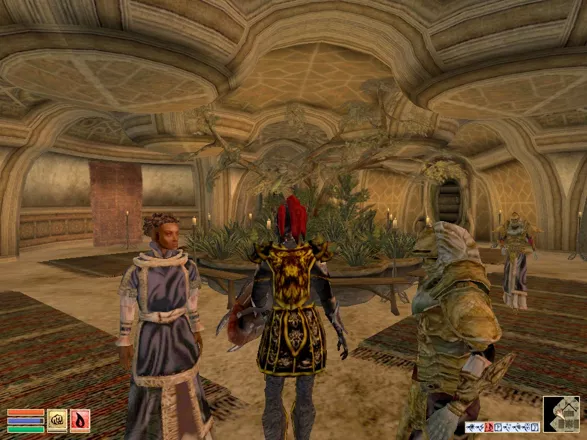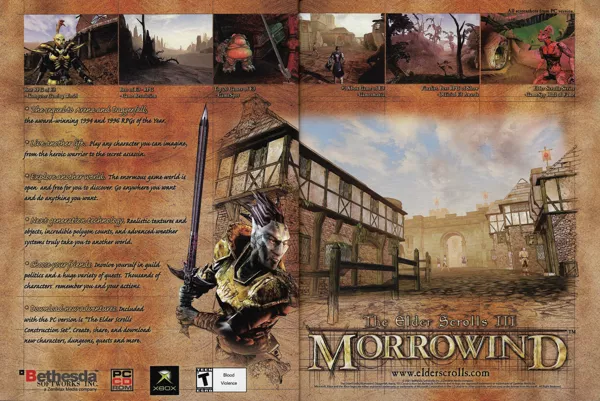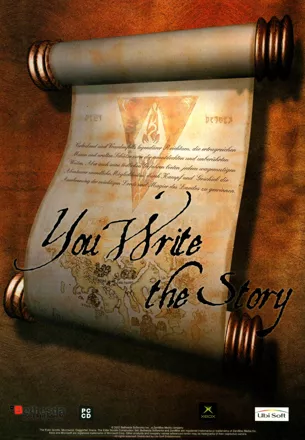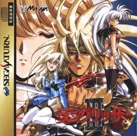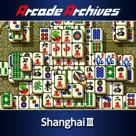The Elder Scrolls III: Morrowind
Description official descriptions
Freed by the decree of Uriel Septim VII, the Emperor of Tamriel, a lone prisoner is transported to the province of Morrowind. It seems that the strange dreams this prisoner has been having lately may have a connection to equally strange events occurring there. The protagonist is given a simple assignment: join the Blades, a secret organization whose goal is to protect the safety of the Emperor. This leads to a discovery of an ancient prophecy and an evil scheme concocted by a powerful deity whom the protagonist alone is able to stop.
Conceived in the tradition of the Elder Scrolls series, Morrowind is a fantasy role-playing game with a vast world open for exploration. After being released from a prison ship at the shores of the island Vvardenfell, the protagonist may do more or less what he or she wants: follow the main quest and solve the mystery of an ancient prophecy, join any of roughly a dozen guilds and rise in their hierarchy by performing duties, or simply explore the gigantic island with its stylistically diverse cities, hundreds of dungeons and tombs, ancient ruins and mighty fortresses.
Morrowind uses a two-stage skill system. The hero’s primary stats (strength etc.) increase with each level gained, while secondary abilities improve by use – for example, the more often the character jumps, the more proficient he or she becomes in the Acrobatics skill, etc. The action-oriented fights are simple exchanges of strikes or spells, until one combatant dies. The enemy's hit points and condition were not originally shown; however, at the request of customers a health bar was added for enemies as part of the first upgrade patch.
The protagonist's race and gender, but also his or her reputation influence the reactions of NPCs. If a character’s sympathy for the hero is low (rated on a scale from 1 to 100), he might refuse to answer questions; if it is high, the player will get more detailed information and better bargains in shops. Most quests involving other persons can be solved by persuasion, pick-pocketing, or simply by force.
The game's NDL 3D game engine is powerful in drawing wide, detailed outdoor landscapes as well as complex indoor environments. Transitions are not fluent; houses and dungeons must be loaded upon entering.
Spellings
- 上古卷轴III:晨风 - Simplified Chinese spelling
- 上古捲軸 III:魔捲晨風 - Traditional Chinese spelling
Groups +
- Animals: Cats
- Console Generation Exclusives: Xbox
- Covermount: Fullgames
- Elder Scrolls series
- Fantasy creatures: Dwarves
- Fantasy creatures: Elves
- Fantasy creatures: Orcs
- Gameplay feature: Alchemy
- Gameplay feature: Burden / Encumbrance
- Gameplay feature: Character development - Repetition
- Gameplay feature: Drowning
- Gameplay feature: Equipment quick slots
- Gameplay feature: Hunting
- Gameplay feature: Journal
- Gameplay feature: Paper doll inventory
- Middleware: Bink Video
- Middleware: Gamebryo / Lightspeed / NetImmerse
- PC Gamer Presents games
- Physical Bonus Content: World Map
- Protagonist: Female (option)
- Software Pyramide releases
- Technology: amBX
- Ubisoft eXclusive releases
- Xbox Classics releases
- Xbox Platinum Hits releases
Screenshots
Promos
Videos
Add Trailer or Gameplay Video +1 point
See any errors or missing info for this game?
You can submit a correction, contribute trivia, add to a game group, add a related site or alternate title.
Credits (Windows version)
118 People (80 developers, 38 thanks) · View all
| Project Leader | |
| Lead Designer | |
| Lead Programmer | |
| Lead XBox Programmer | |
| Lead Artist | |
| Lead Character Artist | |
| Programming | |
| Additional Programming | |
| World Art & Building | |
| [ full credits ] | |
Reviews
Critics
Average score: 89% (based on 83 ratings)
Players
Average score: 4.0 out of 5 (based on 285 ratings with 23 reviews)
Fun game if only somewhere else
The Good
After some playing, what strikes me the most with Morrowind is it's great overall open ended feeling, both positively and negatively. You can walk to wherever you
want and do the quests you want to do, in any order you want. It's fun just traveling the island and chance
upon an impressive castle or some old ruins to explore. And with some skill in lockpicking even breaking into some house in
the city and steal the money can be good fun sometimes. The freedom to play around is very creative and stimulating for
the imagination. That also applies to the creation of your character, which can be tailored very much to your liking.
And as each of the main professions has its own guild on the island there is the possibility to join one of them and do
quests for them. There are even vampire clans to join! Like a lot of other RPG's the game is full of details, like books and stuff, and if you decide to steal something
and someone spots you, you lose reputation points. And it's not to good to be low on reputation as it makes it difficult
to talk to the NPC's.
What I really like about this game is that even after you have finished the main quest you can continue playing, which is to the credit of the creators and shows that they really had a vision of a game as open ended as possible. This is something I have missed in a lot of other games because I always wanted to have the chance to keep playing with my favourite character even after I had finished. To be true, there is no real end to this game, and in that sense it is truly open ended in the best sense of the word.
To top it off, the graphics are very nice with beautiful water effects and the day has its rotation with light and darkness.
During the night you can see the stars shining in the night sky, and inside the houses there are burning fireplaces and
candles, in contrast to the shadows which adds much to the nice atmosphere.
The Bad
There was ONE big problem that kept me from wanting to play. The landscape of Vvardenfell is boring. A dead wasteland with
huge funguses and giant insects that serves as transports between the cities. Everything is brown and colourless. Highly
uninspiring, and I don't understand why the designers wanted such a world, blah. A lot of the NPC's lack personality and
are rather repetitive in their dialogue. The creatures of the island spawn very randomly and that doesn't feel very
realistic. This is a feature of these kind of open ended games but doesn't feel very good implemented here.
To increase a skill you can practice that skill in the game in real time. So if you want to improve your acrobatics
skill, all you have to do is jump all the way to your destination and it will increase. Interesting thought
but quite silly in practice. If it had been better implemented it could have worked. You also advance in combat
with experience and here it works better except that in the beginning you are so bad at fighting that when you
encounter a hostile rat on your first journey, you have to fight like a tiger not to get killed. And that even if you are
armed with a sword. Sure, you get better at fighting with increasing experience, but having problems with
bashing a rat. Give me a break.
The Bottom Line
As I said, the environment was the biggest obstacle for me to enjoy this game, which is sad because it IS an exciting game
in itself despite all of it's flaws which are inherent in this series of games, and stems from having such an open endedness.
I personally prefer the island in the expansion Bloodmoon which has more traditional forest terrain.
Windows · by Vashna (17) · 2007
Bethesda software has come up with the single greatest game ever...
The Good
I don't know how they did this, how long it took, and how much effort was put in it, but I do know, it is the best game ever.
When Arena was released, it tried to break away from other RPG's and distinguished itself. It could have been great, but Bethesda failed to make it fill its potential. A while later, Daggerfall came. It could have been great, but the graphics and stability pulled it down. And now, Morrowind has arrived, and boy is it good! The game features some of the best graphics ever seen, along with a very impressive array of races, characters and quests. But still what astounds gamers is the size. You can explore Morrowind to its greatest. You can follow the main plot, take some side plots, or join a guild and perform duties. Or you can just do anything you want. The hundreds of items and weaponry is very impressive, and the detail put in the game is simply amazing.
The Bad
The only thing I didn't like about this game was the character build. Polygon placement in coordination with the "spine" (as i call it) build makes some characters move stiffly, and it looks rather stupid.
The Bottom Line
Nevertheless, this game is a must have for gamers, whether you like RPG's or not, this game is a must.
Windows · by ThE oNe (180) · 2002
The Good
Daggerfall, the predecessor of Morrowind in the Elder Scrolls series, was a very ambitious game that captured the hearts and the minds of many hardcore role-players, at the same time "scaring away" those who were overwhelmed by the size of its world and its openness. Some people felt it was too big, with too much random design, both for locations and inhabitants.
Morrowind corrects that right away by offering us what is undeniably its most valuable asset - its world. The world is the star of the game, a goal in itself; and it is quite amazing. Without doubt, it is one of the most mesmerizingly beautiful and attractive worlds ever to grace a video game.
Of course, the technical quantum leap contributed to the quality of the game's environment. The vision of Daggerfall was still slightly ahead of its graphical capacities; in Morrowind, technology caught up with imagination. No more desolate, poor sprites decorating the landscape; no more pixelation and drab textures. Morrowind is significant as one of the visually most advanced role-playing games in history; not ever since the first Ultima Underworld have we seen an RPG that challenges first-person shooters in graphical prowess. Yes, the characters could have used some more work, but both in- and outdoor areas are beyond reproach, and the water is absolutely gorgeous. I honestly can't recall another game from that time and even a few years later with such beautifully rendered water.
This world, however, becomes much more memorable thanks to its artistic side, its strong personality and sense of style. The province of Morrowind is exotic: giant mushrooms cover the lairs of strange creatures; majestic urban architecture co-exists with the native dwellings of the dark elves; twisted mountain paths, dark caves, rivers glistening under the busy sky - the world of Morrowind is a marvel, and it is worth to play this game just for its exploration.
And this exploration, like in the previous Elder Scrolls games, is absolutely unrestricted. You can go wherever you want right from the beginning. The gigantic world (yes, much smaller than in Daggerfall, but still much bigger than in most other games) is open to you, and you are free to get to know it in any order, from any side you want. It has more charisma and mysterious charm than its predecessor, and a much more logical and coherent structure. I also liked the fact that you had to physically travel to towns rather than being magically transported to them through the world map. The freedom of movement is exhilarating; it's hard to play other games after Morrowind because they feel so limited in this aspect.
The world is also meticulously detailed, with people and objects everywhere; you can talk about thousands of things and get thousands of items. There is a huge amount of quests, several large factions to join, and so many different locations that you can easily complete the game while having seen only a small fraction of what it has to offer. This kind of generosity makes role-playing particularly rewarding: you are given the freedom to be what you want to be, unbound by moral constraints (except your own) and restricted accessibility to places and quests.
I think the series' trademark system of "practicing" skills is excellent. I love this steady, focused approach to leveling up, and I love the fact that with enough patience you can get overpowered. The whole point of role-playing is to start low and then reach tremendous heights. Morrowind brilliantly conveys this feeling. You start as a nobody, with a lousy weapon and no armor, easily killed by medium-sized creatures in the wilderness. But slowly, through exploration, questing, item-gathering, and not the least practicing, you can become a mighty, feared warrior who can take on Daedric lords and other assorted creatures of darkness. This process is extremely addictive, since there is hardly any limit to what you can discover and do in this game.
The main story may be less intriguing than in Daggerfall, but it nevertheless offers some interesting missions, and is generally enveloped in an aura of mystery that fits the gameplay very well. There is little urgency in the main quest, and it differs in its format from the usual "save the world" template. This goes well with the whole idea of "making your own story", building a biography for the protagonist by yourself rather than doing exactly what the designers told you to do.
The Bad
There is less randomness in Morrowind than in Daggerfall, but repetition and artificial widening of content is still evident. Yes, the world is populated by hundreds of NPCs with whom you can discuss various topics; but after a while, you begin to notice that these characters tell you the same stuff over and over again. There are no truly memorable characters in this world; 99% of the NPCs are signposts, drones devoid of personality and useful only for obtaining quest and basic info. You can try to conduct the conversation in such a way that you avoid the incessant "job description" dialogue ("I'm a thief. Thieves steal things and then sell them for profit. We also have a Guild, with branches located in the following cities... etc."), but then you may miss out some important info and will be left with pitiful one-sentence introductions that say nothing about what kind of person the character in question is. I still can't understand why the same writers who created all those wonderful books that can be found in the game world couldn't bother to write decent conversations.
The quests improve only slightly over the "I need you to kill a person. I will pay you 1437 gold pieces" of Daggerfall. With a few exceptions, the quests involve simplistic and repetitive tasks that offer no moral decisions, hence diminishing the game's value as an RPG. There is a lot of indifference in the people of Morrowind, and I couldn't help thinking sometimes that, in the long run, it didn't really matter what I did or did not in the game. The static, dry inhabitants of Morrowind form an unpleasant contrast with its beautiful art; it is as if someone put a curse on these people, making them apathetic and nearly lethargic, with intimidatingly robotic reactions to any crime the protagonist commits, and completely oblivious of anything else around them.
All this creates a feeling of emptiness, a certain coldness and loneliness that gradually creeps out and eventually takes over. Morrowind is a fascinating trip, but one that resembles an archaeological expedition more than a visit to a functioning, normal country. One may argue that this isolation is deliberate, intending to emphasize the complete freedom by eschewing any attachments to the characters; but that is a far-fetched theory. I'm sure that it was possible to populate the game's world by interesting people without harming its image as a "create your own story" experience.
The Bottom Line
Morrowind was the game that propelled its creators to stardom, and I think its success was fully deserved. We can complain all we want about its weak side quests and lack of interesting characters, but its majestic scope, its sensual beauty, and the exhilarating freedom of its gameplay are unparalleled. Forget about story, forget about goals: let yourself melt in the gigantic, strange world, and perhaps you will see how you slowly find yourself unable to leave it.
Windows · by Unicorn Lynx (181775) · 2014
Discussion
| Subject | By | Date |
|---|---|---|
| Add Game Group | karnak1 (22) | Dec 24, 2012 |
| Morrowind vs. Oblivion | Unicorn Lynx (181775) | Jul 26, 2007 |
Trivia
1001 Video Games
The Elder Scrolls III: Morrowind appears in the book 1001 Video Games You Must Play Before You Die by General Editor Tony Mott.
Content
Morrowind is told to include 3244 NPCs, 316.042 hand placed objects, 480 billion possible characters to create and play, 150 billion spells by using spellmaking in the game, and six full sized novels worth of text.
Creature differences
Some monsters and creatures went through drastic visual changes from Daggerfall and Battlespire to Morrowind. First, the type of khajiit are the same as those presented in Redguard, while the Dremora were turned from fair-skinned, horned demons to black and red-skinned demons. Harpies were replaced with (visually at least) Winged Twilights, and other monsters such as the slaughterfish, orcs and others remain much the same, though much better looking in true 3D.
Graphics
Ever wonder why Morrowind can run at such a slow FPS sometimes and why the game is notorious for making even expensive, fast systems (as of 2004) seem slow? The answer is simple; polygons. While playing the game you'll encounter vast areas full of people, objects and architecture. All these are made from polygons and require the videocard to process them. Morrowind has possibly the heaviest counts of polygons in a single video game, most likely surpassing every game before it and still with a vast number more than contemporary games.
References
There is a single daedric crescent from Battlespire hidden in Morrowind, but getting to it requires some work and initiative (it isn't a part of any main or faction quest), or access to a hint guide.
Awards
- 4Players
- 2002 – #9 Best PC Game of the Year (Readers' Vote)
- Computer Games Magazine
- March 2003 (Issue #148) - #3 overall in the "10 Best Games of 2002" list
- Computer Gaming World
- April 2003 (Issue #225) – RPG of the Year
- GameSpy
- 2002 - PC RPG of the Year
- 2011 – #14 Top PC Game of the 2000s
- RPG Vault
- 2002 - Game of the Year
- 2002 - Role-Playing Game of the Year
Information also contributed by calavera, Jason Musgrave, ShadowStrike and WildKard
Analytics
Upgrade to MobyPro to view research rankings!
Related Sites +
-
Baldurdash
Kevin Dorner's site has bug fixes for Morrowind -
Elder Scrolls III: Morrowind
The official homepage of Elder Scrolls III: Morrowind. Contains general information, downloads, art, and plug-ins. -
Hints for Morrowind
Need just a few clues about Morrowind? These question and answer hints provide nudges before the final solutions are revealed. -
Morroblivion
A free mod that brings Morrowind into Oblivion by converting the game files. -
Morrowind Summit
A Morrowind fan site containing vast amounts of information about the land of Morrowind and how to create your own Morrowind adventures. -
Morrowind at RPGDot
Contains news, information, and downloads for Elder Scrolls III: Morrowind. -
Telesphoros' List o' Mods
One man's opinion of the ESSENTIAL fan-made enhancements (mods) to the Morrowind world. -
The Elder Scrolls III: Morrowind - FAQs & Guides
A multitude of walkthroughs, faqs, maps, text files on Morrowind. -
Wikipedia: The Elder Scrolls III: Morrowind
Article about the game in the open encyclopedia -
Wiwiland
French modding community with a lot of exclusive mods.
Identifiers +
Contribute
Are you familiar with this game? Help document and preserve this entry in video game history! If your contribution is approved, you will earn points and be credited as a contributor.
Contributors to this Entry
Game added by NeoMoose.
Xbox One added by Kennyannydenny. Xbox Cloud Gaming added by Sciere.
Additional contributors: PCGamer77, -Chris, Unicorn Lynx, Jeanne, OFoglada, Shoddyan, Sciere, Aubustou, Paulus18950, Patrick Bregger, FatherJack, Kennyannydenny.
Game added May 10, 2002. Last modified April 19, 2024.
